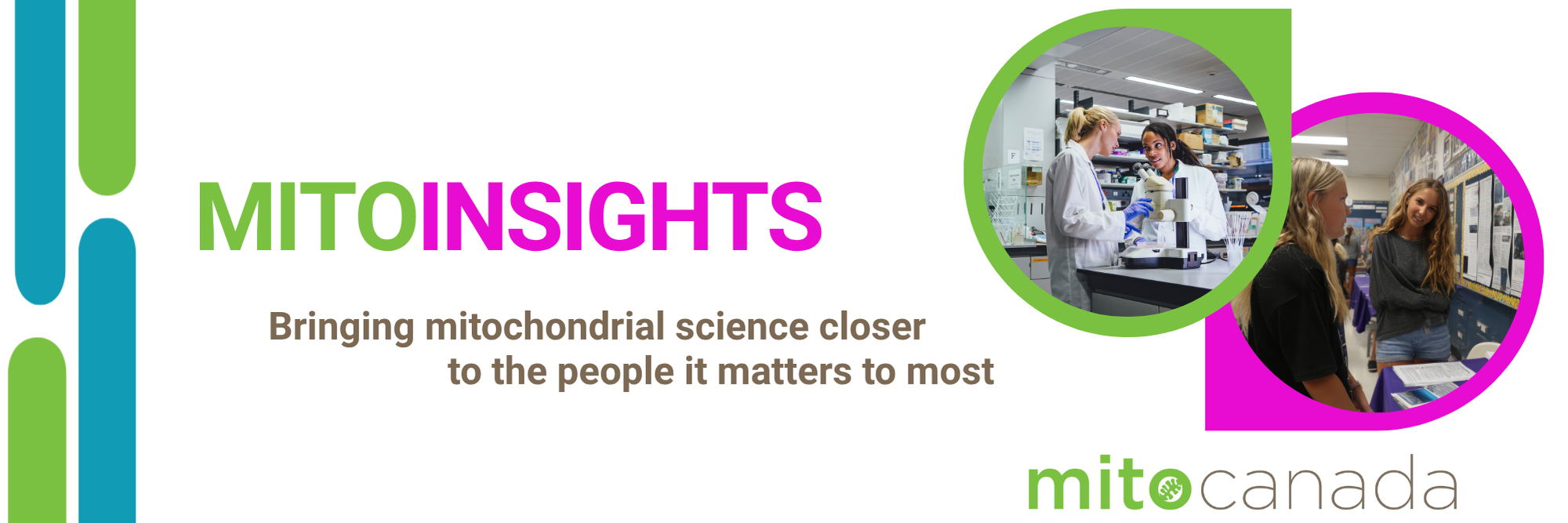Science moves fastest when everyone can take part. That’s why MitoCanada is committed to empowering our community with knowledge. By translating cutting-edge mitochondrial research into clear, easy-to-understand summaries, we aim to nurture curiosity, strengthen understanding, and build confidence in the science driving hope and progress.
Lay Summary: Mitochondrial-Targeted Therapy Prevents Early Onset Muscle Weakness in Ovarian Cancer
Authors:
Luca J. Delfinis¹†, Shahrzad Khajehzadehshoushtar¹†, Luke D. Flewwelling¹, Nathaniel J. Andrews¹, Madison C. Garibotti¹, Shivam Gandhi¹, Aditya N. Brahmbhatt¹, Brooke A. Morris¹, Bianca Garlisi², Sylvia Lauks², Caroline Aitken², Leslie Ogilvie⁴, Stavroula Tsitkanou³, Jeremy A. Simpson⁴, Nicholas P. Greene³, Arthur J. Cheng¹, Jim Petrik², and Christopher G.R. Perry¹*
What’s this research about?
This study explored how mitochondrial health affects muscle strength during cancer, and whether a special antioxidant therapy could protect muscles from weakening. The research team focused on ovarian cancer, which often causes cachexia, a condition where muscles waste away, leading to fatigue, weakness, and poor quality of life.
But the scientists made an important discovery: muscle weakness actually starts before muscles shrink or lose size. That means something other than muscle loss, such as mitochondrial dysfunction, might be the early cause of this weakness.
What are mitochondria and why do they matter?
Mitochondria are the “power houses” inside our cells. They generate the energy (ATP) that our muscles need to contract and function. When they’re damaged or stressed, as often happens in cancer, they can produce too many reactive oxygen species (ROS), or “free radicals.” These molecules can damage cells and lead to fatigue and weakness.
The big question
Can improving mitochondrial health before muscle loss occurs protect strength in people with cancer?
How did they study this?
The research team used a mouse model (a research method using mice that share important biological similarities with humans) of ovarian cancer that closely mimics how the disease progresses in humans. They treated some mice with a compound called SkQ1, a mitochondria-targeted antioxidant that acts like a shield inside the mitochondria, reducing oxidative stress and helping mitochondria function better.
They tested:
- Muscle strength in both the legs and the diaphragm (breathing muscle)
- Mitochondrial energy production and oxygen use
- Signs of inflammation and oxidative stress
What did they find?
- Muscle weakness happened early, even before the muscles showed signs of shrinking (atrophy).
- SkQ1 helped preserve muscle strength in both early and late stages of cancer.
- SkQ1 did not stop muscle loss, but it made muscles stronger and more efficient despite atrophy.
- The therapy improved calcium handling inside muscle cells, helping them contract properly. Calcium handling refers to how muscle cells control the movement of calcium, an essential mineral that acts like an on/off switch for muscle contraction.
- The positive effects were linked to healthier mitochondria, less oxidative stress and more stable energy metabolism.
In short, SkQ1 helped keep muscles “powered up” longer, even while cancer progressed.
Why is this important?
This is one of the first studies to show that muscle weakness and muscle wasting are not the same thing, and that mitochondria play a key role in strength loss during cancer.
By targeting mitochondria directly, scientists may be able to:
- Delay or reduce early weakness that affects mobility and breathing
- Improve quality of life for people living with cancer
- Potentially make the body more resilient during cancer treatment
What could this mean for future therapies?
The findings highlight mitochondria as a promising therapeutic target for cancer-related muscle weakness.
If similar results can be confirmed in humans, mitochondrial-targeted therapies like SkQ1 (or similar compounds such as MitoQ and SS-31) could one day:
- Help people maintain strength and independence during cancer
- Complement existing treatments
- Improve recovery and energy balance in other diseases linked to mitochondrial dysfunction
In simple terms
Cancer doesn’t just cause muscles to shrink, it makes them weak by hurting their mitochondria first. This research shows that by protecting the mitochondria early, we might keep muscles stronger for longer, even in the face of disease.
Why this matters to the MitoCommunity
This study deepens our understanding of how mitochondrial dysfunction contributes to weakness and fatigue, symptoms shared by people with mitochondrial disease. It reinforces that muscle health depends on mitochondrial health, and that therapies aimed at stabilizing mitochondrial function can have far-reaching benefits, not just for cancer patients but for anyone affected by energy metabolism disorders.
For the MitoCommunity, this research offers hope that the same principles, protecting mitochondria to preserve strength and energy, could one day be applied to treating mitochondrial diseases directly.
Acknowledgment
This research was led by Dr. Christopher G.R. Perry at York University’s Muscle Health Research Centre, with contributions from Luca J. Delfinis, Shahrzad Khajehzadehshoushtar, Dr. Jim Petrik, Dr. Nicholas Greene, and colleagues from York University, the University of Guelph, and the University of Arkansas.
Their collaborative work provides new insight into how protecting mitochondrial health can help preserve muscle strength during cancer progression, deepening scientific understanding of the relationship between mitochondrial function and muscle health.
This MitoInsights was reviewed and approved by a member of or members of this publications authorship.
Explore the orginial publication or download our layperson article today:
Do you have a question about this article? If so, we’d like to hear from you. Please send us an email!

